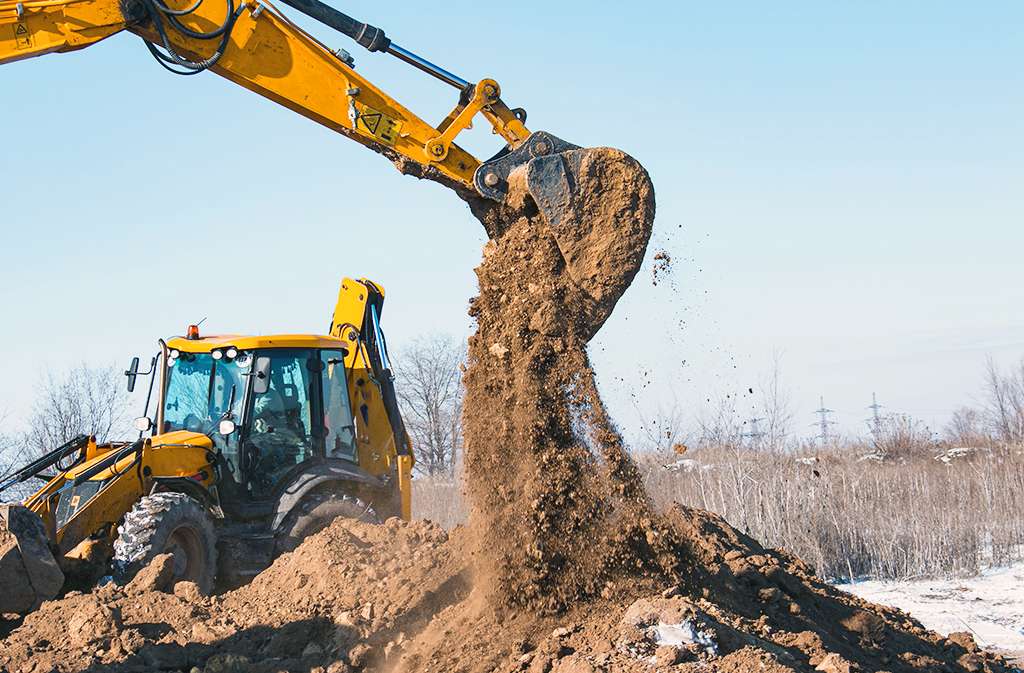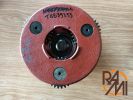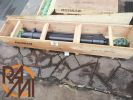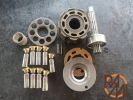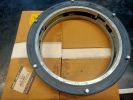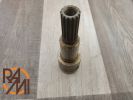In this article we will give an overview of the world of construction equipment: types, uses, risks, maintenance...
You will find everything you need to know to approach the world of construction equipment with the right awareness, even if you are starting from scratch!
So let's get to the heart of the matter: which machines can be defined as "earthmoving machinery"?
Types of earthmoving machinery
Excavator

The excavator is a type of construction machine characterized by a single, extendable boom on which various attachments can be mounted, including:
- Buckets, for digging the ground
- Grabs and shears, for crushing or cutting concrete or metal works
- Pneumatic hammers, to break rocks or construction works with extreme precision
- Augers, for drilling into the ground
- Brush cutters and shredders, for removing plant cover
This makes the excavator a very versatile piece of machinery and therefore very common on construction sites.
Excavators, depending on the chassis, can be divided into tracked and wheeled excavators. Tracked excavators move by means of tracks. They are slower but appreciated for their stability and high load capacity. Wheeled excavators move by means of tyres similar to those on cars and trucks. They can achieve a higher travel speed but, on the other hand, their load capacity is limited.
Mini-excavators deserve a separate mention. These are small tracked excavators (under 60 quintals) that are used in all places where the 'full size' excavator will not reach.
Loader

As its name suggests, the loader is an earthmoving machine that allows the collection of large quantities of soil or other bulk materials.
The large front loader, attached to the chassis by means of two hydraulic booms, makes it possible to lift material in larger quantities and more efficiently than excavators.
Like excavators, loaders are divided into tracked and wheeled loaders. The latter are the most common.
Backhoe loader

The distinguishing feature of backhoe loaders is the combined presence of a loader at the front and an excavator arm at the rear.
They are generally versatile and compact, making them the Swiss Army knife of construction machinery.
Although they are not as efficient as specialized machines, they are used in areas where, for environmental or economic reasons, it is better to work with a single machine.
Dumper

The function of the dumper is to load and move material such as earth, rubble and other bulk materials that are loaded by wheel loaders or excavators. Its use is therefore similar to that of a wheelbarrow, proportionally of course!
The body can be tipped, allowing the contents to be unloaded quickly. Depending on the model, the cab of the dumpers is installed in front or behind the body.
The models also differ in size. There are huge dumpers, suitable for work in quarries and open spaces, as well as lighter models suitable for use in city centres.
Scraper

The bulldozer is a construction machine consisting of two elements: a trailer and a tractor, both with tyres. Its role on the construction site is to level the ground. It is also known by the English name of scraper.
Bulldozer

The bulldozer is used to move large masses of material horizontally by means of its large, slightly convex and usually toothless front shovel.
This heavy machinery was one of the first to become widespread, and became very popular following the World War II, when it was used on a massive scale to clear European cities of bomb debris. Today, the bulldozer is relatively rare on construction sites, although it is still well known even to the uninitiated.
The largest Heavy Machinery models
The fascination of construction machines is also due to their huge dimensions. There are truly immense models on the world market.
Here is a brief review of the frontrunners in this field.
The world's largest excavator
ThyssenKrupp's Bagger 288 is a crawler excavator manufactured in Germany. The dimensions are titanic:
- Length 240 metres
- Height: 96 metres
- Weight: 13,500 tonnes
Because of its impressiveness and unique appearance, it has been featured as a prop in several films.
The world's largest wheel loader
The LeTourneau L-2350 is the giant among wheel loaders.
It can lift around 72.5 tonnes of material in one load at a maximum height of 7 metres. The tyres, cyclopean to say the least, have a diameter of no less than 4 metres!
The world's largest dump truck
This record belongs to the Belarusian Belaz 75710.
At 20 metres long, 8 metres high and 11 metres wide, this huge dumper weighs 360 tonnes, which together with its 450-tonne maximum load capacity makes a total of over 800 tonnes! In order to move such a heavy vehicle, four engines with a displacement of no less than 130,000 cc are required!
Today, only three Belaz 75710 are known to be in service in Siberian coal mines.
...and the smallest Heavy Machinery
Just as there are giant heavy equipment, there are also very small ones.
Without a shadow of a doubt, the smallest construction machine in the world to date is the Komatsu PC01 mini excavator. Only 300 kg in weight for a machine in which everything is reduced to the bare essentials.
In addition to its size, another interesting aspect of this machine is its battery power. As a result, it is a quite unique case of an earthmoving machine that can also be used indoors without any special precautions to collect exhaust gases.
The machine is suitable for small agricultural work, while it is of little use for construction because, being very light, its output is rather limited.
Outside the field of mini excavators we find the JCB 1CXT mini tracked backhoe loader, which is designed for agricultural and forestry work. Very versatile, it can move over uneven terrain and mountain trails with some agility.
Its weight is around 3.5 quintals, which is the minimum needed to be able to function as both an excavator and a wheel loader.
Now that you know the types of construction equipment, you may be wondering where to start when buying one?

Buying construction machinery: what you need to know
How to choose the right earthmoving machine for you
First of all you should choose your machine based on 3 factors.
- The type of work. As we have seen above, each type of earthmoving machine is specialised for a specific type of task. If you have to dig, an excavator is ideal, as is a loader if you have to load material.
- The load of earth to be moved. This estimate will give you an indication of the size of the vehicle and its capacity.
- The location of the work. Rough or sloping terrain requires tracked vehicles, which are more robust and stable. Locations far from the place of loading and unloading, on the other hand, are suitable for wheeled vehicles due to their greater travel speed.
By meditating on these criteria, you can get a rough idea of the type of machine you need.
For the purchase, there are still four elements to focus on:
- The service point
- The brand
- The model
- Possible accessories
Which is by no means a given, especially for those who do not know the market in depth.
For this reason, construction companies often turn to construction equipment salesmen explaining their needs. In return, they receive advice and suggestions on the most suitable makes and models for the job at hand.
Famous construction machinery brands
There are so many brands of construction machinery currently on the market that an exhaustive list could not be compiled.
Among the most famous heavy machinery brands we can mention:
- Caterpillar (often called CAT)
- Case Construction Equipment
- Doosan
- Bobcat
- Hitachi
- Komatsu
- Volvo
Buying an earthmoving machine
Have you decided to buy an earthmoving machine? You have several options in front of you...
Buying new construction machinery
For the purchase of new equipment you generally turn to dealers, just as you do for cars. RAMI srl di Pietro Assolari, which has been operating in the sector for over 50 years, is one such company.
In addition, it is possible to trade-in the old vehicle if it is available. The estimated value of the vehicle given in exchange will be deducted from the final price of the new car. This is very attractive if the intention is to renew your fleet.
Buying used construction machinery
Used machines are a viable alternative for purchasing construction machinery. In this case, you can turn to various parties.
Buying used construction machinery from specialist companies
As a rule, professional sellers of construction machinery also offer used machines, which are checked by specialised mechanics before they are sold. Faulty or heavily worn parts are replaced to ensure the proper functioning of the vehicle.
Heavy machinery dealers are structured companies, so you have good purchase guarantees. In addition, the bureaucratic phase of the transfer of ownership is handled more quickly. That is why we would recommend a safe purchase from a dealer to less experienced users.
Buying construction machinery from private individuals
Buying from private individuals is an alternative that can offer many interesting bargains.
By “private individuals” we do not only mean natural persons, but also all companies that are not professionally involved in the sale of construction machinery. The typical case is a construction company liquidating a vehicle due to non-use.
Buying from private individuals tends to be riskier than buying from a dealer, both because it is not always easy to assess the reliability of the occasional seller and because the used vehicle is not checked by mechanics before it is sold. The risk is that you end up with a construction machine with problems and that is unlikely to be returned, since it is sold on a 'seen and liked' basis.
Construction equipment auctions
The third option is judicial auctions. This is where equipment confiscated as a result of irregularities, debts, and bankruptcies of construction companies converges. Used construction machinery in excellent condition can often be found, but not always.
The rules for access to auctions change according to the local authority. Our Italian customers, for example, can participate in a judicial auction, apart from the debtor of course. In order to participate in the auction, it is necessary to go through some bureaucratic rigmarole and (very important) to leave a deposit of 10 per cent of the bid amount.
Doubts or insecurities when buying used construction equipment? We have written a guide that can help you avoid the most unpleasant situations: https://www.rami-spare.it/en/spare-parts-blog/mistakes-not-to-make-when-buying-a-used-excavator
Construction equipment for rent
If the work for which you need an earthmoving machine is limited to a short period, renting can be very convenient.
Many people, including professionals, choose this formula for three reasons:
- Low costs compared to purchasing
- Large selection of fully functional machines
- Absence of maintenance and obsolescence costs
Construction equipment can be rented either from dealers offering the service or from companies specialised in the rental of construction equipment.
Who can drive a construction machine
Imagine you have already purchased your construction machine. It is just waiting to be put into operation to do its job.
Who can drive it?
Construction machine licence: is it a legal obligation?
Please note: this paragraph talks about the regulation on the subject in the territory of the Italian Republic. If you reside in a country other than Italy, the local regulations may be different.
So far we have heard all kinds of things in our field. That is why it is important to clarify!
The licence is compulsory for the operator who carries out a job and is therefore employed by a company.
Therefore, a licence is always required to work with construction machinery.
Private use, on the other hand, is not yet covered by legislation.
However, it is still advisable to obtain an earthmoving machine licence for private use, even if it is not strictly compulsory.
Earth-moving machinery licence course
The licence to drive excavators and wheel loaders is obtained after attending a special course. The training is carried out both in the classroom with theoretical and practical lessons.
The licence, or rather the certificate of competence for the use of earth-moving machines, is issued to the student who has attended at least 90% of the course and has passed a series of theoretical and practical tests.
Once issued, the licence lasts for five years. It must be renewed by attending 4-hour Earthmoving Machinery refresher courses.
Heavy Machinery accidents: the most common cases
Construction machines are generally large machines that appear to be extremely solid and robust, so robust that they seem invulnerable! However, the numerous videos of construction machinery accidents on YouTube and social platforms show that even these machines hide pitfalls and dangers.
Fortunately, it is enough to comply with safety regulations on construction sites, together with a little common sense, to avoid most of the risks!
Overturning
This is a fairly common type of accident among construction machinery. When loading oversized quantities of earth, stones or other heavy objects by means of booms or shovels, machines can lose their balance.
Particular attention must be paid to tipping when working on a slope or if piles and other objects are present under the wheels or crawler.
Working on the edge of the excavation can also be extremely dangerous. In the event of ground subsidence, the vehicle can fall or get stuck.
Impacts and investments
Heavy Machinery generate a lot of power. In addition, they are often large vehicles. This combination makes construction machines particularly dangerous.
The operator engaged in his work may not notice things, people or animals within range, especially during manoeuvring. Needless to say, being hit by a machine weighing several tonnes can have very serious consequences. That is why it is good to keep a safe distance from construction machines in action.
We sometimes hear of construction machines running over pylons, light poles, walls, because the operator did not pay attention to the path while driving.
It is only right, however, to put in a good word with heavy machinery operators. Sometimes accidents with earthmoving equipment are not their fault, but the truck drivers who transport the machines. It happens, unfortunately, that truck drivers forget that they have a load with booms and overhangs... and slip under a bridge or into a bottleneck, with consequences that are easy to guess.
Misuse of Heavy Machinery
Here we enter a vast field. Misuse is potentially infinite.
Recorded and absolutely wrong behaviour in the use of construction machinery includes:
- Daring manoeuvres. This is typical of excavators who have the impression that they have the machine totally under control. One should never give these machines too much confidence because it is very easy to operate the wrong control at the wrong time.
- Load your machine without using the ramps. Tipping is assured.
- Let other people in the cab besides the driver.
- Sit in the excavator bucket and use the boom as a lift.
- Leave the keys in the cab when you are not present. This is not only to prevent theft, but also to prevent someone else from using the excavator instead of you and causing damage that you could be held liable for.
Some tips for driving earthmoving machines safely
- Golden rule: do not use the excavator if you do not know how to use it.
- Follow the safety rules in the machine's user manual and in the regulations in force.
- You should only use the machine if you are not alone on the construction site. If you will have an accident, someone will be able to intervene promptly and assist you.
- Never drive over landslides or over objects that can throw the machine off balance. If you find an obstacle, it is best to go around it.
- Keep a safe distance from the edge of the excavation.
- Always use seat belts and do not lean out of the driver's cab.
- Do not let other people in the car. There is only room for the driver.
- Do not exceed the technical limits of the machine: do not push too far forward or too high with the excavator arm, for example.
- Pay attention to slopes: the loaded bucket must never be turned from the uphill side to the downhill side.
- Avoid standing in the range of action of the heavy machinery.
- Absolutely do not use construction equipment to lift people.
- Only get on and off the machine when it is switched off. Do not get out when the machine is in motion (even if it tips over).
- Do not leave the keys in the cab when getting off the machine. When not using the excavator, keep the keys with you or in a safe place.
- Keep the machine's equipment healthy by having it serviced by competent professionals
- Replace damaged parts in good time. For this you can choose new, used or reconditioned parts from our website!
Maintenance of construction machinery
Over time, heavy equipment tend to wear out. To reduce the risk of breakdowns, maintenance is carried out, which consists of:
- Routine maintenance (servicing). A general overhaul of the engine and components of the construction machine to be carried out every 500 or 1000 working hours. This is not a legal obligation but is strongly recommended.
- Greasing. Lubricating oil is added to the mechanical components to reduce friction and thus wear.
In the event of faults, extraordinary maintenance is carried out. This is carried out by specialised mechanics who replace damaged parts with new, used or reconditioned parts.
Scrapping of construction machinery
When the machine has too much damage to be fixed, it is scrapped.
This operation, which is carried out by specialised companies, involves an examination of the machine to check whether some of its components are still in good condition. In this case, these components are removed, repaired and resold as spare parts.
This is the work for which we at RAMI Spare specialise!
Depending on the case, used spare parts can be reconditioned. This means that they go through a process of selection, repair and replacement of damaged or worn parts. Finally, the reconditioned part is tested to ensure that it functions properly. The result, in terms of performance and appearance, is no less than a new part!
But why is it useful to keep parts in good condition from old construction machines? There are several reasons:
- Savings. A used part generally costs less than a reconditioned part.
- Timing. New spare parts for construction machines have to be ordered from the parent company, and delivery times are not always tight. Used parts, if available, can be used immediately.
- Availability. The life cycle of construction machines is quite long. On construction sites it is not uncommon to find machines over 20 to 30 years old. Spare parts are no longer produced for many of these machines. And this is when the used part becomes not only useful, but also indispensable!
This is the overview of things to know when approaching the world of construction machinery. Of course, the field is vast, and there are many more things to tell.
So we recommend that you follow us on Instagram, Facebook, Linkedin and visit The Spare Parts Blog.

